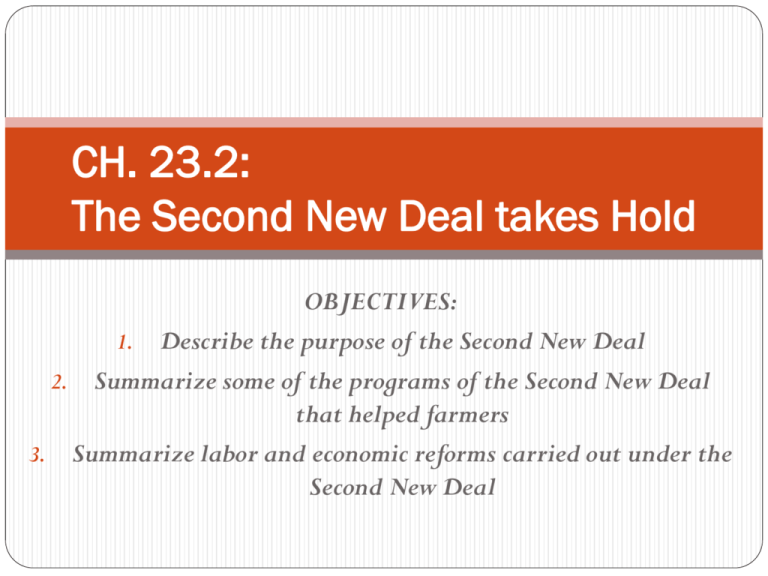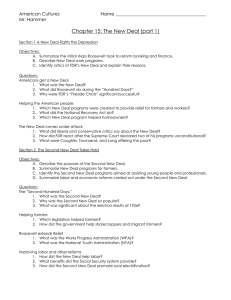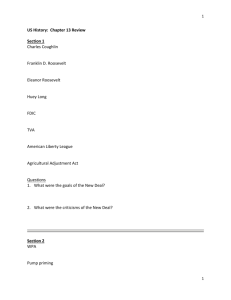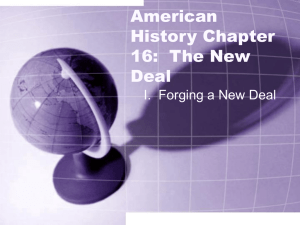
CH. 23.2:
The Second New Deal takes Hold
OBJECTIVES:
1. Describe the purpose of the Second New Deal
2. Summarize some of the programs of the Second New Deal
that helped farmers
3. Summarize labor and economic reforms carried out under the
Second New Deal
“Forgotten Man”
Unemployment remained high
Forgotten Woman
Govt. work programs and
production still lagged behind
the levels of the 1920s
1934 elections – Democrats took
over the House and Senate even
more
Roosevelt and his wife, Eleanor
Roosevelt pushed for Congress to
provide more extensive relief for
farmer and workers
Forgotten Woman
President Franklin D. Roosevelt campaigned on helping
the "forgotten man." As shown in this political cartoon
Eleanor Roosevelt, the First Lady, did not forget women.
She worked diligently to ensure that they benefited from
the New Deal and had access to government and the
Democratic Party. (Franklin D. Roosevelt Library)
Copyright © Houghton Mifflin Company. All rights reserved.
Election of 1936
Landon (Republican), Gov. of Kansas
FDR (Democrat), incumbent
ISSUE: “waste” and radicalism of New Deal
OUTCOME: 523 to 8 for FDR
ANALYSIS: FDR built a new coalition of South, blacks,
urbanites, poor and “New Immigrants”
HELP FOR FARMERS
Recovery starts with the first AAA, but the Supreme Court
strikes it and other New Deal programs down as
unconstitutional in 1936 because it contained taxes for
subsidies.
1938- Congress passes “Second” Agricultural Adjustment Act
(AAA), without the subsidies tax.
Helps sharecroppers, small farmers, migrant workers
Loaned more than a $1 billion to farmers
HELP FOR PROFESSIONALS, YOUTH, AND ARTISTS
Works Progress Administration (WPA)
Employed 8 million between 1935 & 1943
Repaired roads and streets; built libraries, schools
and hospitals
FOCUS: Unskilled workers construct public
works;
Skilled workers (artists, teachers, architects)
hired to create cultural, literary, and
intellectual “common goods.”
National Youth Administration (NYA)
PART time work for youth (vs. FULL time in
CCC)
Early Labor Relations
NIRA receives broad “legislative” powers
Writes codes of “fair competition”
Receives cooperation of labor and business – at first
Continuing economic stagnation erodes voluntary nature of codes
Supreme Court kills NIRA with Schechter decision
unconstitutional delegation of legislative powers
regulation of INTRA-state commerce unconstitutional
PWA (Public Works Administration) replaces NRA
and proves more successful and more constitutional.
New Deal for Labor
Wagner Act
Schlechter decision & collapse of NIRA
Guarantees self-organization and collective bargaining
Fair Labor Standards Act of 1938 – Establishes maximum hours
and minimum wages (EXCLUDES domestics, farm workers
and service workers)
Unions reward FDR at election time
Social Security
1935
1. Old-age insurance for retirees 65 or older
and their spouses
You would get an amount based on how
much you contributed
2. Unemployment compensation system
Federal tax on employers
3. Aid to families with dependent children
and the disabled
Financed by Federal funds
NOTE!!! Had to be employed to
get coverage!!!
Social Security poster
Enacted in 1935, Social Security has been one
of the most enduring of all New Deal programs.
This poster urges eligible Americans to apply
promptly for their Social Security cards.
(Library of Congress)
TERMS
Eleanor Roosevelt
OBJECTIVES:
Describe the purpose of the
Second New Deal
2. Summarize some of the
programs of the Second
New Deal that helped
farmers
3. Summarize labor and
economic reforms carried
out under the Second New
Deal
1.
Works Progress Administration
National Youth Administration
Wagner Act
Social Security





